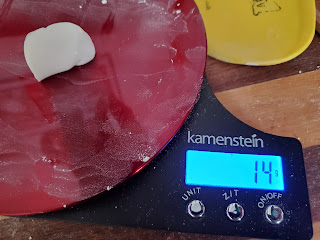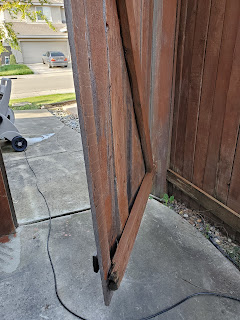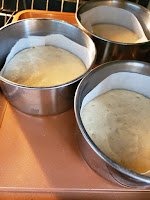This MITARASHI DANGO #4 testing is made from a combination of two different glutinous rice flour. The DANGO turned out perfectly soft chewy, yummy snack without all that xanthan gum, starch, etc. The combination of glutinous rice powders are DANGO flour and glutinous rice flour from Thailand.
Some of you have seen this glutinous rice flour from my postings on Chinese New Year Cake. Why combine? because this DANGO Flour is no longer being sold at DAISO for $1 or $1.50 and is quite pricey at MITSUWA or at DAIWA. And I need to make a lot to share with everyone.
Ingredients are the same as other postings on the DANGO.
For this combination, it is:
250 g DANGO flour
250 g GLUTINOUS RICE FLOUR (green bag)
Add 180 ml of warm water, and have another 180 ml of warm water ready. (You might not need all of second cup of 180 ml warm water.)
Combine with warm water; mix. Add other 180 ml of warm water 1 Tablespoon at a time. Mix in until you have a soft supple dough -as soft as earlobe soft but not wet.
Bring a large pot of water to a boil. Put enough water for the dough ball to float during cooking,
Roll into a ball. Divide into quarters.
Roll one into a rope.
Cut into 14 g pieces - weighed on scale.
Cover the rest in a bowl to keep from drying up.
Roll a piece between your palm into a ball.
If it feels like it is about to crumble - don't worry - without opening your palm - press down to the dough and rub the dough in a circular motion to form it back into a round ball.
place on plate.
Cook at high heat. Place the dough balls into the boiling water while stirring the water to keep the dough from sticking to the bottom of the pot.
Wait for the water to come to Boil again.
TIP: Have a cup of cold water on the side. If the water in the pot boil over, you can add a bit of cold water to calm it down or adjust the heat control.
But the DANGO must be cooked over high heat for 2 additional minutes after they float to the top.
Have a bowl of cold water ready.
Scoop the cooked DANGO into cold water.
Prepare the MITARE syrup. Double the following recipe.
MITARE (sweet sauce for the DANGO)
Sugar 100 g
Soy sauce 50 ml
MIRIN 30 ml (Japanese cooking wine)
Water 180 ml
Potato starch - KATAKURIKO 20 g (*or more - test it - DO NOT use CORN starch; arrow root starch is okay.)
New technique: Mix in a pot: sugar and soy sauce and MIRIN, and 50 ml of water first to dissolve sugar.
Bring the liquid to low boil.
Mix the rest of water and Potato starch (KATAKURIKO) together.
Get READY MIX Vigorously - Add the starch slur to the hot liquid in the pot.
Turn the heat to medium.
Stir and cook until it becomes translucent.
Continue cook over medium heat - stir, stir, stir... until water evaporates and syrup becomes absolutely "thick" and sticky. Control heat temperature as needed.
Keep scraping the bottom of the pot and sides to keep from burning the syrup.
Becareful not to burn yourself. It will become lava like.
It is done when it sticks to your spatula without drooling down so quickly. The thicker the better. (*A bit more starch at the beginning would have helped, I bet.) Cooking period: 20 - 30 min. << This is too long. *shows that more starch would have helped.
NEW technique: Set it aside to cool for 5 - 8 min.
Strain the DANGO.
In a large ceramic skillet. Rub some cooking oil. Place all the DANGO in it to brown one spot of the dango.
*Try not to let the DANGO touch each other while browning.
Normally, you skewer three to a stick because "4" is not a lucky sound in Japanese. I was just trying to save the stick's real estate.
Skewer to a stick.
Dip in MITARE syrup. Actually, it is more like scoop the syrup with a spoon and 'wrap' the syrup around the DANGO.
Serve.
This recipe kept the DANGO soft for many hours. I wish I can say for two days or even after refrigeration, but they are always eaten up, so can't tell. Let me know how long yours lasted and stayed gummy yummy.
The following combination of this flour and Thai Glutinous rice flour turned out not so desirable.
This DANGO flour is specific for the type of pastry as pictured and perfect for that. It is a combination of 50% Glutinous MOCHI flour and 50% URUCHIMI - rice flour. But if you want the chewy DANGO on the stick that we want to make stick to the recipe I gave above. This combination here produced DANGO that are firmer and just don't give that satisfying mouthfeel. I thought I might have not put enough water or boiled long enough in the past test, but I think it's just is the characteristic of this flour.
It's almost plasticky. But looks good.
As you can see from the pictures, the MITARE syrup really really need to be thick and sticky. And browning process on the skillet help dry up the surface to help syrup to adhere to the DANGO. And definitely maybe a bit more KATAKURIKO would help the process. Because stirring for 30 minutes to wait for water to evaporate to thicken the syrup tells you that additional KATAKURIKO would helped. I will try that next time.























































